Physical Address
304 North Cardinal St.
Dorchester Center, MA 02124
The skull is divided into three portions: the neurocranium, the face, and the base. The neurocranium is composed of the membranous portions of the occipital, parietal, frontal, and temporal bones, and is bounded inferiorly by the base of the skull, which includes the sphenoid and ethmoid bones. The face is between the forehead and chin.
Routine skull radiographs include the frontal projection, Towne view of the occipital bone, and the lateral view. Submentovertical, Waters, and Caldwell (posteroanterior 15 degrees) views may be added for specific indications.
The radiation dose (with the thyroid and lens being the most sensitive structures) varies with the view obtained and the age of the patient. Best practice skin doses for a lateral skull range from 0.09 mGy in the first year of life to 0.46 mGy in a 10- to 15-year-old child (see in Suggested Readings ).
Indications for skull radiographs are listed in Box 18.1 . Computed tomography (CT) and magnetic resonance imaging (MRI) are used for evaluation of intracranial contents, facial structures, craniosynostosis, and trauma.
Trauma in possible child abuse cases (as part of a skeletal survey)
Syndrome evaluation
Craniosynostosis (initial test)
Physical findings in patient without neurologic symptoms
Cephalhematoma
“Bump”
Foreign body (initial test)
Metastatic workup for small round cell tumor
Initial evaluation in facial trauma
Mild trauma
Neurologic abnormalities (use computed tomography or magnetic resonance imaging)
Sinusitis evaluation
During infancy, the neurocranium is larger relative to the face. Neurocranium to face ratios in the lateral projection are roughly 3 : 1 to 4 : 1 at birth, and decrease to 2 : 1 to 2.5 : 1 by age 6 years. The calvarium is an incompletely mineralized membranous capsule with individual bones divided from one another by connective tissue sutures and fontanelles. The six major fontanelles are located at the four corners of the parietal bones—two in the skull midline and two pairs on each side ( Fig. 18.1 ). Accessory fontanelles may occur in several locations but usually are in the sagittal suture. The sutures and the skull base synchondroses are prominent in newborns but diminish in width during the first 2 to 3 months. Obliteration of the sutures does not begin until the second to third decades. Figs. 18.1 through 18.4 and e-Fig. 18.5 illustrate sutures, fontanelles, and synchondroses.
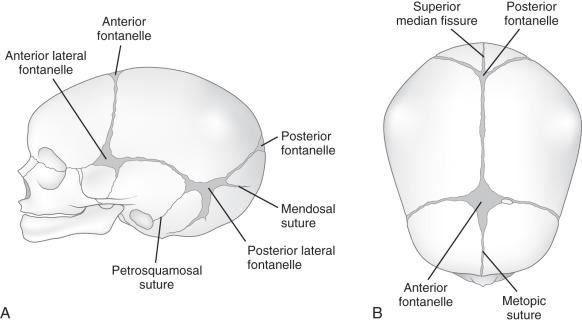
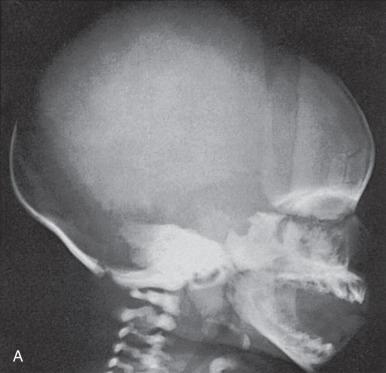
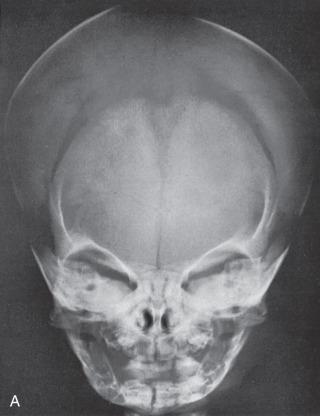
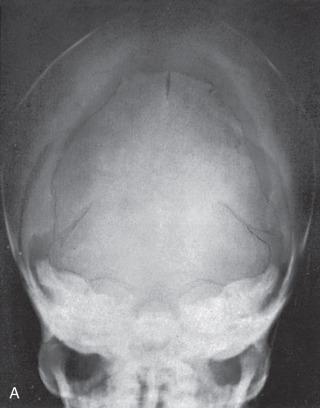
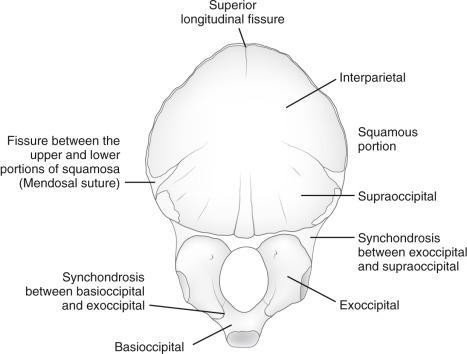
The sphenoid bone at birth consists of a single central mass composed of the body, lesser wings, and two symmetric lateral masses, each of which includes a greater wing and a pterygoid process. The pituitary fossa is round with smooth margins; the dorsum sella is short and blunt, and the clinoid processes are rudimentary. The angle between the body of the neonatal mandible and the ramus in lateral projection is about 160 degrees; the bodies are separated by a midline cartilaginous symphysis mentalis (see Fig. 18.3 ). Early tooth calcification is seen in the fifth fetal month.
Components of the individual ununited bones in infancy may cause confusion if they are not correctly recognized. The frontal bone is divided in half by the metopic suture (see Figs. 18.1 and 18.3 ). Apparent discontinuity of the sphenoid bone with the frontal bone superiorly and the occipital bone posteriorly indicates sites of the sphenoid synchondroses (see Fig. 18.2 ). The four components of the occipital bone (see Fig. 18.2 and e-Fig. 18.5 ) likewise may simulate discontinuities.
Most of the postnatal skull growth occurs during the first 2 years of life, after which most of the features of the adult skull are present. During the first 2 years, the bone thickness increases. The inner and outer tables, diploic space, vascular markings, and grooves for the dural sinuses develop by the end of the second year.
With increasing age, the fontanelles and sutures become smaller and narrower. The anterior fontanelle is reduced to fingertip size during the first half of the second year; the posterior fontanelle may be closed at birth (range of closure: birth to several months). Closure of the fontanelles occurs clinically before it is visible radiographically. The metopic suture is variable and may close from birth to the third year; however, it persists in about 10% of adults. In the occipital bone, the mendosal suture (see Fig. 18.4 and e-Fig. 18.5 ) disappears during the first 2 years, but can persist. The synchondrosis between the supraoccipital and exoccipital (supracondylar) portions disappears during the second or third year. The spheno-occipital synchondrosis begins to close near puberty but may persist until the 20th year. Extensive variation makes sutures an unreliable criterion for estimation of age. Around the 20th year, the skull attains its definitive size.
Intrasutural, or wormian, bones occur most frequently along the lambdoid sutures ( Fig. 18.6 and e-Fig. 18.7 ; Box 18.2 ), and less frequently in the fontanelles (see e-Fig. 18.7 ). The interparietal or Inca bone ( Fig. 18.8 ) results from division of the supraoccipital portion of the occipital bone into two parts by the mendosal suture, with the superior part arising from membranous bone and the inferior part from cartilage continuous with the supracondylar basiocciput. A rare synchondrosis runs vertically through the squamous occipital bone ( e-Fig. 18.9 ); persisting superior and inferior portions of the line are known as the superior longitudinal fissure (bi-interparietal suture) and the cerebellar synchondrosis (median cerebellar suture). Where the supraoccipital portion of the occipital bone forms the posterior border of the foramen magnum, accessory supraoccipital bones occasionally are found ( e-Fig. 18.10 ). An outward bulge of the occipital squamosa just above the torcular Herophili in a newborn ( Fig. 18.11 ) is called bathrocephaly . Rarely, a horizontal interparietal suture divides the parietal bones into superior and inferior moieties ( e-Fig. 18.12 ).
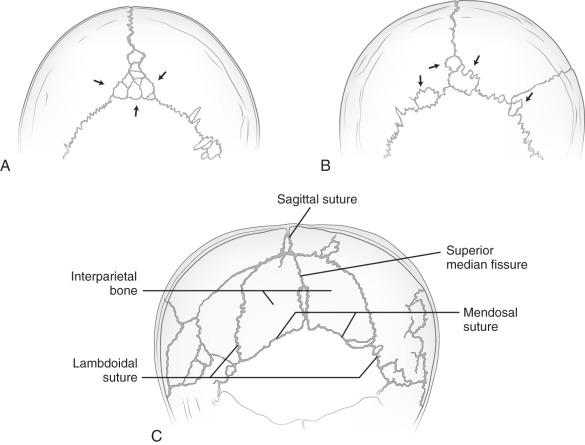
Hypothyroid (cretinism)
Become a Clinical Tree membership for Full access and enjoy Unlimited articles
If you are a member. Log in here